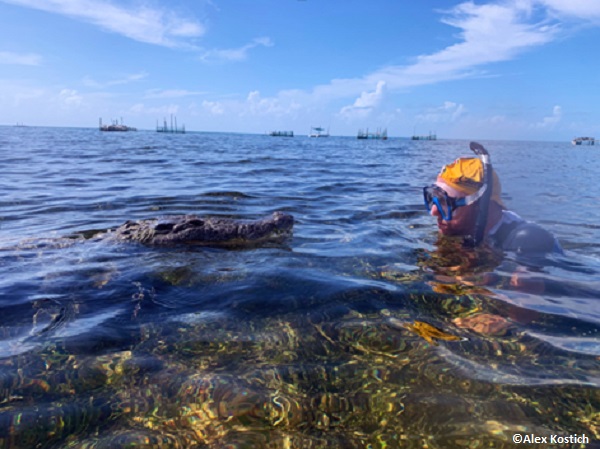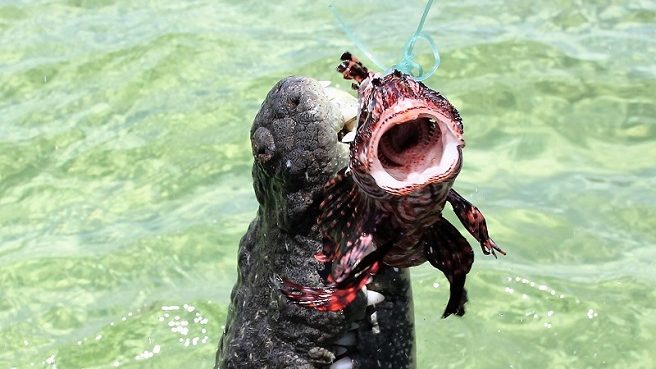Part 3 continues the journey with Christian Kemper as he dives with crocodiles in Mexico.
Ernesto starts splashing around in the water with a bucket and another crew member throws a lionfish on a line into the sea. The noises attract the crocodiles.
The idea is not to feed them with the fish, but to lure them into our vicinity and keep them there, like the carrot that you swing in front of a donkey.
After about 30 minutes we see a tree trunk which floats against the current. A tree trunk with eyes—the first crocodile is here! The splash of the fish on the surface of the water is like a food bell for the crocodiles.
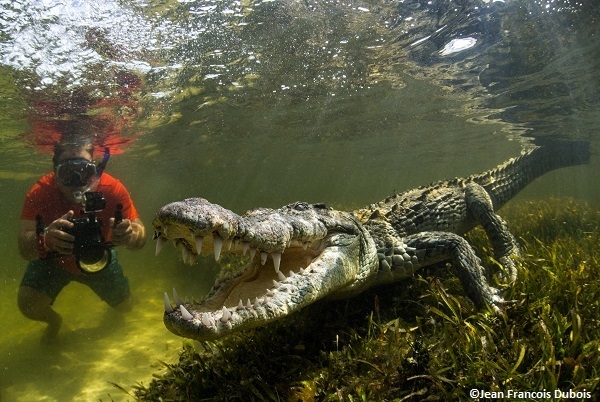
Now quick into the water, because no one knows how long the crocodile stays. Alex and I agreed to be the first—not sure if that was a good idea, but I traveled thousands of miles and spent two months’ salary to get up close with a crocodile in the water.
So, cameras ready and take a deep breath. The heart beats, adrenaline shoots through the veins! A leisurely reef dive is nice, but sometimes it has to be the big adventure. Diving on the limit with crocs is not for the faint-hearted. Encounters with three-meter saltwater crocodiles boost the circulation.
The crocodile is slightly elevated in the seagrass and is waiting—for us? In front of our hut is a spot without seaweed, only sand. Ernesto tells us “the seagrass is for the crocodiles. Here they feel safe. The sand is for us. We never swim in the sea grass, that could get uncomfortable!
Sometimes, when the crocodiles really feel relaxed, they come to us onto the sand. Do not panic, keep an eye on the animal, and never turn your back on them, then everything will be fine!?
Do not panic, OK.
Strangely, I’m really chilled and enjoy watching the animal underwater. It’s big, damn BIG. I guess it’s over 3 meters (9ft)!
“That’s Gambit,” Eli screams from above.
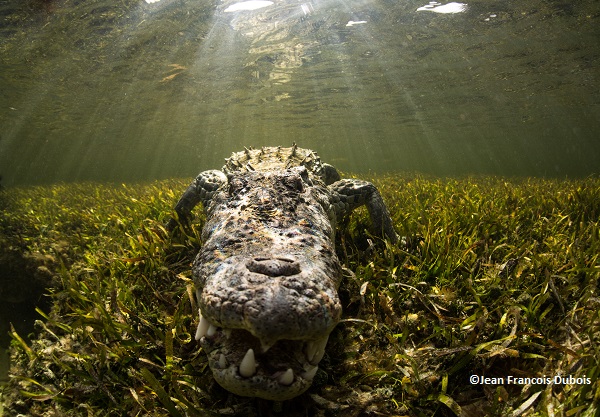
Gambit is the biggest crocodile here in the area. I had heard of him and hoped to see him. And Gambit is really cool, if you can say that. He is totally calm and waiting for the fish.
Splash! The fish lands right next to his mouth. Bright white teeth are smiling at me, some as big as my little finger. Slowly he grabs the fish and does not respond aggressively when the fish is pulled away. The whole game repeats itself several times and Gambit stays cool. Lazy, like a big St. Bernard, as if to say, “Guys, I know the game. Take your photos, give me the fish and I’m good.”
Then two more crocodiles appear which are a bit smaller. One of them is called Cut Tail; part of his tail is missing, it was likely bitten off in a fight.
Cut Tail is approaching and wants the fish for himself. Curious, the reptile looks at the camera before nudging the lens. Suddenly it rips open its mouth and lashes with its muscle-bound tail into the seagrass, toward the bait.
These hunters should not be underestimated. But the king of the area has something against it. Gambit bites at Cut Tail, and makes it pretty clear who’s the boss. Crocodiles are very anxious to defend their territory and only the largest is allowed to eat. This ranking usually prevents them from killing each other.
Cut Tail is looking for space, swimming right at us and Ernesto has to keep him at bay with his stick.
Now Gambit is quickly swimming toward us and we have to make room. Blocking the way of a crocodile is not a good idea. When they feel constricted, they grab at anything that moves.
In fractions of a second, the water is completely stirred up with sediment and we cannot see anything! Just keep calm.
There are three of us in the water with two big crocodiles, but where are they? There are certainly more reassuring feelings than being in the water with two very large, wild crocodiles that nobody can see.
Slowly, we stalk to the place where we suspect them. Under the water surface? Nothing. Above the water surface? Nothing. Where is Gambit? We look a bit nervously around us and continue snorkeling.
A glance down and we suddenly realize how masterfully these reptiles can camouflage themselves in the green-brown seagrass. Motionless, the impressive animal lies practically directly below us and examines these strange snorkelers on the surface of the water. After some time, it decides to turn up and swim toward me directly from below.
What does it want? Just to test me like great white sharks sometimes do and check if I will panic? Or just breathe? I decide to dodge gently to the side. Will it follow? No. It pops up right next to me, nose and eyes out of the water, and looks at Alex and me with interest.
Carefully, we take more photos. Our armored reptile friend lies indifferent on the spot, while we fight against the slight current and at the same time try to take some good photos.
Meanwhile, Cut Tail and the other crocodile have withdrawn a bit and Gambit is back in the seagrass. The game can continue.
We take countless, stunning photos and come close to Gambit. VERY close. If I wanted, I could have kissed him on the nose. But I’m not that stupid. Because the powerful jaws of crocodiles are their most sensitive zone; in the skin of this area, they possess countless highly sensitive sensors that register even the finest touch.
With these skin sensors on the jaw, the animals can feel vibrations in the water and, on direct contact, can distinguish tasty prey within milliseconds from inedible objects. For the crocodiles, this also means that they can perceive pressure waves on the water surface and thereby find their prey even in the dark. A touch, therefore, would not be advisable.

Once again, Gambit comes to us onto the sand.
In this moment I get a bit queasy. If he wanted to, he could just bite my head off. Ernesto’s stick would not help much. But I also stay cool.
Somehow, I instinctively feel that there is no danger from this animal. Gambit looks at us curiously, but in the end he’s only after the bait on the line. When he gets it, he swims away satisfied, like a dog with a bone.
Exciting how different the behavior of crocodiles is.
Alex has the same feelings. “Cut Tail was a sweet little hot fire, but Gambit was pretty chilled,” he laughs at me.
There’s a group change. Each group of two is allowed to spend 20 to 30 minutes with the crocs in the water. Now it’s Johnny’s and Greg’s turn. And the whole game is repeated. Overall, the three crocodiles stay with us for about six hours and everyone gets enough time with them. What a first day!
“Most of the crocodiles in Banco Chinchorro are undoubtedly extremely good-natured and will accept people in their immediate vicinity,” explains Eli on the veranda in the evening.
“However, it is still an instinct-driven ambush predator when it comes to food. Since crocodiles have very good hearing, they react, like sharks, to splashing noises in the water. So, you should not pee from the dock into the water tonight. We’re still talking about wild crocodiles that could easily rip out an arm or leg of a human being.”
But why does that not happen, I want to know?
“First of all, the favorite prey species of American crocodiles are fish, birds, and here in Banco Chinchorro, also the green iguanas, which does not really put us on the menu as human beings,” Eli says.
“Their size also limits the prey spectrum. Most crocodiles here are between 5 to 9 feet (1.5 to 2.7m) long, and therefore too small to kill a grown man. In addition, they are generally more tolerant to humans than the Nile crocodile or the Australian saltwater crocodile.
“If you follow the rules already mentioned, you can dare to swim with them in the water,” Eli continues, “but do not be fooled. If we entered the mangroves, that would be quite another matter. There, they are at home and it is their actual hunting area. They would probably attack us immediately! But with us in the open water, they are more restrained. The conditioning certainly plays a role, too, because the crocodiles here or in the Jardines de la Reina in Cuba, have gotten used to people,” he explains.
This concludes Rock the Croc! Diving with Crocodiles, Part 3. Look for Part 4 soon.
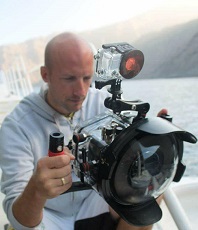
Christian Kemper is a TV journalist from Germany and freelance writer for three of the biggest diving magazines in Germany. He has been diving with and studying sharks for more than 20 years. The author has written two books about shark attacks and is about to publish his first English language book about sharks titled “The Fear Beneath.”
You can find his German Language book “Strange Pool Friends” on Amazon and at tredition.
He has also written several articles about sharks.

